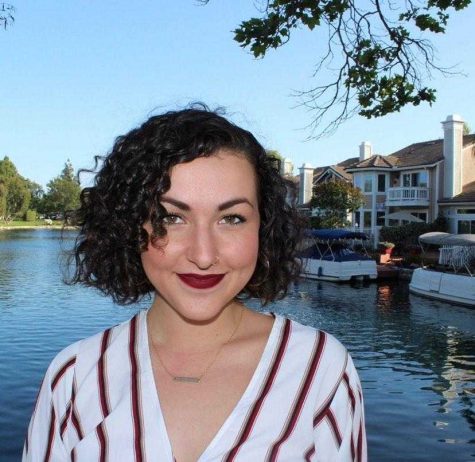“Looking for Alaska” Portrays Mental Health Well

“Looking for Alaska” Portrays Mental Health Well
Looking For Alaska exemplifies how TV shows should depict mental health. (Courtesy of Twitter)
Looking For Alaska exemplifies how TV shows should depict mental health. (Courtesy of Twitter)
October 30, 2019
Hang on for a minute...we're trying to find some more stories you might like.
Email This Story
On Oct. 18, Hulu released all eight episodes of its latest miniseries, “Looking for Alaska,” based on John Green’s novel of the same name. Focusing on a group of friends at an Alabama boarding school, the show tackles the topic of mental health in a poignant and respectful way. (Caution: major spoilers ahead!)
When viewers tune in to the first episode of the show, titled “Famous Last Words,” the show is prefaced by a short introduction by leading cast members. Charlie Plummer, who plays Miles “Pudge” Halter, and Kristine Froseth, who plays Alaska Young, warn the viewers not to drink and drive as well as encourage them to seek help if they are struggling with mental health issues.
The show has partnered with several important organizations including The Jed Foundation, Mental Health America and the National Alliance on Mental Illness. All of these resources are available at hulu.com/looking-for-alaska-resources, which is listed at the end of every episode.
The television series chronicles the boarding school adventures of Pudge, Alaska and their friends Takumi and The Colonel. The gang is a magnet for mischief, engaging in a prank war with their classmates. However, as the show progresses, the tone grows more ominous and a countdown at the end of each episode dwindles down. By episode five, the show has reached “One Day Before,” and it becomes clear to the viewer that Alaska is struggling. After she reveals her guilt from the traumatic death of her mother, Alaska begs Pudge and The Colonel to help her leave campus, and she drives away one night in the rain.
“Looking for Alaska” is a portrayal of mental health that resists the simplicity of many television and film depictions. Alaska’s ultimate death after a brutal car accident reads suspicious almost immediately, as Pudge and The Colonel remember the hysterical state she was in when she left. It is revealed that Alaska made no attempt to swerve from the parked police vehicle that she hit. Though she was intoxicated at the time, considering her previous behaviors, her friends suspect that the accident was a deliberate attempt to end her life.
In recent years, Netflix’s “13 Reasons Why” received massive pushback and criticism for its portrayal of adolescent mental health, specifically its handling of the main character’s suicide. “13 Reasons Why” took measures to correct its mistakes after the fact by providing more mental health resources and adding a preface video, similar to that seen before “Looking for Alaska.”
They also opted to completely remove the scene that graphically depicted the main character’s suicide. But as many critics have pointed out, it is too late.
However, the following two seasons were both heavily criticized, with one reviewer from The Guardian writing, “the new season confirms how the series has no moral compass at all.” Though the show is similarly based on an early 2000s young adult novel by Jay Asher, the television adaptation quickly departs from the book material. They add the suicide attempt of another character to the end of the first season, perhaps to keep viewers engaged for a second season. In season two, the finale culminates with a thwarted school shooting attempt.
Instead of handling the topic with care, the portrayal was ultimately lazy and insensitive, with the entire storyline being practically ignored in the next season. Season three shifts gears, promoting itself as a murder mystery after the death of the show’s main antagonist.
“Looking for Alaska” does right what “13 Reasons Why” did wrong. Though Alaska’s friends want to understand what happened, they ultimately realize that it will not change what happened. As one writer from TV Guide described it, “The most essential thing the miniseries does is show that Alaska’s death wasn’t justifiable — that whether her accident was exactly that, or the purposeful taking of her own life, or a mix of both, what happened to her was a tragedy.”
“13 Reasons Why” often acts like Hannah’s death can somehow be made worthwhile by having the recipients of her tapes realize how they hurt her. But no matter how much remorse her classmates may have, Hannah is still dead. Her death is final, and the show’s attempt to keep her presence through voiceover or even a complete hallucination completely ignores this.
“Looking for Alaska” takes an honest and heartfelt portrayal that shows the real impact of a young death. While the lack of answers may seem unsatisfying as a storyline, it is far more realistic, and ultimately, a far better message for young audiences.
Inaccurate or insensitive portrayals of mental health conditions such as anxiety, depression or suicide can have significantly detrimental effects on viewers, especially those who are young and impressionable or already struggling with the conditions. With the recent declaration by the Center for Disease Control that suicide rates have increased over 50% in teenagers from 2007 to 2017, it is more important than ever to raise awareness and provide portrayals in the media that will help teenagers understand how to deal with mental health issues. “Looking for Alaska” shows promise that the future of mental health in the media, especially in shows geared toward teenagers, are on the road to improvement. Hopefully, by learning from the mistakes of past attempts, the realm of mental health awareness will only continue to flourish.
Though “Looking for Alaska” includes a great tragedy, it ultimately helps us to learn that the key to overcoming the tumultuous times life will throw at us is forgiveness, both of others and of ourselves. After all, it’s the only way out of this labyrinth of suffering.
If you or someone you know is struggling with mental health issues, please do not hesitate to contact the following resources:












If you want a picture to show with your comment, go get a gravatar.